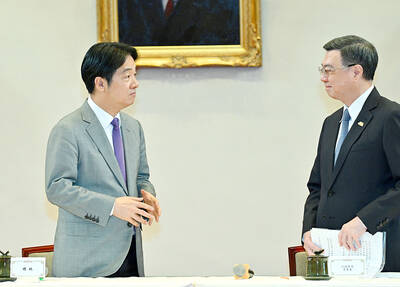The tourism destination of Sun Moon Lake is doing a brisk business these days. With the influx of tourists from China and the recent opening of the No. 6 National Highway (六號國道), Tseng Kuo-chi (曾國基), director of the Sun Moon Lake National Scenic Area Administration (日月潭國家風景區管理處), said that this was one of the few domestic tourism destinations that was continuing to see growth despite the economic downturn.
It has been 10 years since Sun Moon Lake and much of the surrounding area was devastated by the 921 earthquake, which apart from destroying numerous hotels and damaging the transport infrastructure, also caused Guanghua Island (光華島), now renamed Lalu Island, a major scenic attraction of the lake, to all but disappear beneath its surface.
The No. 6 National Highway, the Nantou section of which opened in March, has made Sun Moon Lake a viable destination for a day trip from many major west coast towns north of Changhua County, overcoming the problems of the insufficiency and the high cost of hotel or chalet accommodation around the lake. New hotels are coming up apace, not always to the advantage of the area’s scenic appeal, but there are still views that seem to come directly out of a classical Chinese ink wash painting.
One of those views is from the veranda of The Lalu hotel, one of the grandest local hotels, located on the site of a villa once much favored by Generalissimo Chiang Kai-shek (蔣介石). Laying on a daybed looking over an uninterrupted prospect of the lake, the tiny splash of green that is Lalu Island, and the mist-shrouded hills of the opposite shore, I was glad that I had decided to stay spend more than a day at Sun Moon Lake.
Beneath the veranda, hidden away beyond the infinity pool, is a little-frequented stretch of public walkway that is part of a growing network of walking paths, bicycle paths and shuttle bus services that the Scenic Area Administration is working to complete as part of its effort to make Sun Moon Lake both eco- and visitor-friendly.
The Lalu, from its huge and luxuriously appointed rooms to its personalized ayurvedic spa services, offers many of the features you expect from a top-class international hotel. Its historical associations also make it a popular stop for the boats touring the lake, and the guest’s relaxation is often interrupted by the sound of tour guides announcing that “This is The Lalu, which was extensively redesigned in 1998 … ,” wafting up from the lake.
The remodeled Lalu was designed by Australian architect Kerry Hill, and it fits snugly and remarkably inconspicuously into the hillside on the edge of the lake, in the best traditions of modern, environmentally conscious design. Directly behind it, the Sun Moon Villa Hotel (日月行館), with a design that imitates the billowing sailing-ship shape of the Burj Al Arab hotel in Dubai, clearly wants to be anything but inconspicuous. This blight on the landscape is only one of many glitzy and unimaginative towers that are going up around the lake, aiming to cash in on the market for luxury domestic travel.
Tseng said that efforts were being made to achieve a higher level of regulation for construction, but as the granting of construction permits is not within the remit of the Scenic Area Administration, it remains to be seen how effective these efforts will be. Judging from the construction currently underway, low-profile design does not seem to be a popular choice among the more up-market hotel ventures.
While many are clearly unwilling to be led, clinging firmly to the belief that concrete, glass and steel towers are what tourists want, there are certainly a number of operations such as the Sun Moon Lake Full House Resort (日月潭富豪群度假民宿), a delightful log cabin structure full of idiosyncratic artworks and a lush tropical garden, that are trying for a more laidback and homey ambiance.
Full House is located at Ita Thao, formerly known as Dehua Community (德化社), opposite the town of Shuishe (水社), were The Lalu is located. The town may be small, only three or four streets, but it is the local center of the souvenir and food specialties trade, and also the departure point for a number of walking trails. The hotel is comfortable and imaginatively designed. The service was friendly, if a bit haphazard given that its weekend room rates start at NT$3,200 a night. (It should be pointed out that rates at The Lalu start at NT$15,000.) The food at Full House showed signs that effort had been made to provide a local flavor, with a series of dishes that incorporate local fruit, but these were clearly designed for large parties, and the simpler food was ordinary in the extreme.
Owner Lin Yi-ren (林義人) took the trouble to take guests up the mountain road toward Tannan (潭南) to catch a glimpse of the fireflies that have become a major attraction for April and May. Visiting at the tail end of May, there were only a few spots of light in the darker recesses of the hills, but the lack of people was compensation enough. Lin said that this small mountain road would be lined with parked cars at the height of the season. The firefly season has been heavily promoted by the Scenic Area Administration, and according to Tseng, has proved remarkably successful. Townspeople, many of whom recollect seeing fireflies from their childhood, are eager to share this experience of the rural life with their children, he suggested.
Another successful venture made possible by improved access has been the marketing of Sun Moon Lake as a location for wedding photography.
Tseng emphasized the active part that the Scenic Area Administration is taking in producing marketing synergies, pointing to a new television series, titled Love in Sun Moon Lake (月滿水沙漣), which premiered on HakkaTV (客家電視) on May 18.
This Romeo and Juliet story involves two tea-growing families and makes extensive use of scenic spots around Nantou County. Tea tourism is a new and seemingly successful draw for tourists and romance never goes out of fashion. Sun Moon Lake’s suitability as a destination for romantic getaways was underlined last month by a highly publicized group wedding for 10 couples at the newly refurbish Sun Moon Lake Church of Christ (日月潭耶穌堂), once much used by the Generalissimo when visiting his villa. A whole series of activities, under the title of Love in Sun Moon Lake (愛在日月潭), will take place through to the end of the year (details can be found at www.sunmoonlake.gov.tw/event3/index.html).
Sun Moon Lake is clearly on a roll, but it doesn’t take an expert to see that the area is in considerable danger of becoming a victim of its own success. The narrow and winding lakeside road is prone to congestion, and massive structures like the new cable car linking Sun Moon Lake to the Formosan Aboriginal Cultural Village (九族文化村), which is scheduled to open for business in August, cut huge swathes through the lush greenery of the hills. Boats swarm about what is left of Lalu Island like bees around a hive.
Tseng said that his organization is doing what it can to encourage people, especially local business operators, to treat the environment with respect. Tseng said “many people still see tourism as a predatory use of environmental resources. We have to change this so they recognize the advantages of sustainable development.” He emphasized incentive programs to get boat operators to convert to solar or electrical power, the construction of two wastewater treatment plants to service the scenic area, the development of an efficient public transport network and environmental education targeting schools and local communities.
In the many facilities available to the tourist, whether it be adequate parking, thoughtfully integrated public transport or clean public lavatories, the agency has achieved much in the last 10 years. The hardest part of the battle remains to be fought: Having achieved some success, will it be able to stop people from grabbing at the short term advantage to the ruination of one of Taiwan’s most beautiful scenic spots?

Under pressure, President William Lai (賴清德) has enacted his first cabinet reshuffle. Whether it will be enough to staunch the bleeding remains to be seen. Cabinet members in the Executive Yuan almost always end up as sacrificial lambs, especially those appointed early in a president’s term. When presidents are under pressure, the cabinet is reshuffled. This is not unique to any party or president; this is the custom. This is the case in many democracies, especially parliamentary ones. In Taiwan, constitutionally the president presides over the heads of the five branches of government, each of which is confusingly translated as “president”

Sept. 1 to Sept. 7 In 1899, Kozaburo Hirai became the first documented Japanese to wed a Taiwanese under colonial rule. The soldier was partly motivated by the government’s policy of assimilating the Taiwanese population through intermarriage. While his friends and family disapproved and even mocked him, the marriage endured. By 1930, when his story appeared in Tales of Virtuous Deeds in Taiwan, Hirai had settled in his wife’s rural Changhua hometown, farming the land and integrating into local society. Similarly, Aiko Fujii, who married into the prominent Wufeng Lin Family (霧峰林家) in 1927, quickly learned Hoklo (commonly known as Taiwanese) and

The Venice Film Festival kicked off with the world premiere of Paolo Sorrentino’s La Grazia Wednesday night on the Lido. The opening ceremony of the festival also saw Francis Ford Coppola presenting filmmaker Werner Herzog with a lifetime achievement prize. The 82nd edition of the glamorous international film festival is playing host to many Hollywood stars, including George Clooney, Julia Roberts and Dwayne Johnson, and famed auteurs, from Guillermo del Toro to Kathryn Bigelow, who all have films debuting over the next 10 days. The conflict in Gaza has also already been an everpresent topic both outside the festival’s walls, where

The low voter turnout for the referendum on Aug. 23 shows that many Taiwanese are apathetic about nuclear energy, but there are long-term energy stakes involved that the public needs to grasp Taiwan faces an energy trilemma: soaring AI-driven demand, pressure to cut carbon and reliance on fragile fuel imports. But the nuclear referendum on Aug. 23 showed how little this registered with voters, many of whom neither see the long game nor grasp the stakes. Volunteer referendum worker Vivian Chen (陳薇安) put it bluntly: “I’ve seen many people asking what they’re voting for when they arrive to vote. They cast their vote without even doing any research.” Imagine Taiwanese voters invited to a poker table. The bet looked simple — yes or no — yet most never showed. More than two-thirds of those